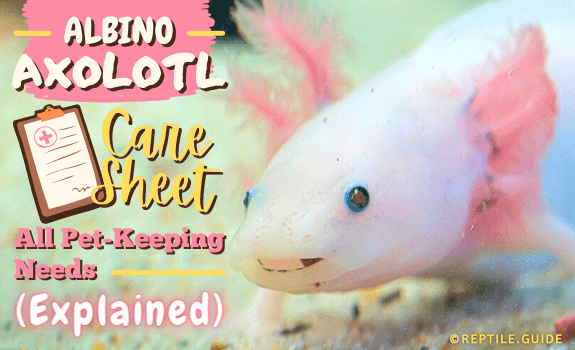The albino axolotl is a distinct morph with a white body, pink gills, and red eyes. Its care is similar to that of other axolotls.
You may see a golden albino axolotl, or a white albino axolotl, both of which are true morphs. Let’s take a closer look at their care and origins.
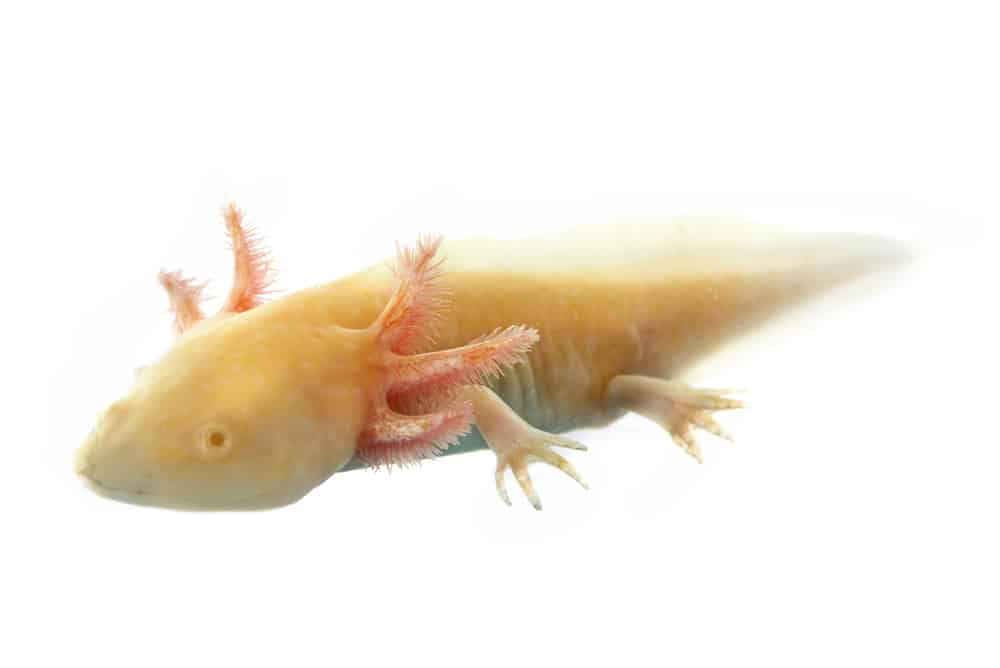
In This Article
Albino Axolotl Background
The axolotl, Ambystoma mexicanum, is an unusual species.
It’s endangered in the wild but is a common pet and lab animal in captivity.
It first became a common lab subject due to its regenerative abilities. These animals can grow back lost tails and limbs.
Explorers discovered the axolotl in the 1860s. They shipped several axolotls to zoologist Auguste Duméril at the Jardin des Plantes.
That original colony of axolotl included at least one leucistic axolotl. It also held the genes that would lead to the albino axolotl.
This group of axolotls became the foundation for ALL pet axolotls in the trade today.
Wild Distribution
The albino axolotl isn’t common in the wild, not having the camouflage needed to survive.
The wild axolotl dwells in lake Xochimilco, in the Valley of Mexico. It also inhabits the canals and waterways of Mexico City.
Wild axolotl distribution has shrunk since the animal was first discovered.
This is due to the draining of several lakes that were a flood risk to the inhabitants of the valley. The introduction of invasive predator species contributed to the decline of axolotls.
Size and Appearance
The albino axolotl looks much like the other axolotl morphs. The sole difference lies in their coloration.
Axolotls are neotenic salamanders that don’t undergo metamorphosis.
A sexually mature adult axolotl resembles salamander larvae but is larger.
Young axolotls and adults alike sport a pair of feathery gills, dark eyes, and short stubby legs, which have earned them the name Mexican walking fish.
They have a distinctive caudal fin extending from the tip of the tail to the base of the neck.
This morph doesn’t produce skin pigments and is a bright white rather than the dark brown of most axolotls.
The albino axolotl has bright red gills and red eyes, unlike other morphs (like the leucistic axolotls).
Adult axolotls reach lengths of up to 12 inches.
Albino Axolotl (“Mexican Walking Fish”) Care
If you take care to keep their water quality high and their diet varied, these animals are easy to care for.
If you have experience maintaining an aquarium, then caring for an albino axolotl is easy.
Water Sources
Axolotls are sensitive to water conditions and need high-quality water with a balanced pH.
You have two main options for a water source:
Reverse Osmosis (RO) – A process where water gets forced through a membrane with microscopic openings. The membrane removes most particles from the water, including chlorine and oxygen. It’s important to oxygenate this water before use.
Tap Water – A cheap, accessible source of water. Our tap water contains high amounts of chlorine to make it safe for drinking. If you’re using it for an axolotl, use a water conditioner that will remove the chlorine from the water.
It’s best to avoid bottled water. Despite what the label might say, you have no proof as to its origin, so don’t know what you’re dealing with.
Pro Tip: Try this if you’re using tap water but don’t have access to a water conditioner. Fill a large bucket with water, stir, then leave it for 24 hours. Chlorine dissolves into the air at a certain rate and will have dissipated after 24 hours.
PH and Water Hardness
As a natural resident of a clear mountain lake, the axolotl has high requirements for water conditions.
The most important are pH and water hardness (how many minerals the water contains).
The ideal pH range for axolotls is between 7.4 and 7.6, but they can handle anything from 6.5 to 8.0.
You can buy a pH test kit from any fish store or pet store.
The kit will help you track the conditions and comes with instructions for modifying the pH level.
You can buy a test kit for water hardness as well. Axolotls prefer slightly hard water and won’t thrive in soft water.
If you live in a hard water area, and you’re using tap water, then water hardness is unlikely to be a problem.
If you’re living in a soft water area or using RO water, then you’ll need to raise the water hardness.
You can do this by adding one teaspoon of each of the following to every five gallons of water:
- Rock salt
- Epsom salts
- Baking soda
Only use rock salt for aquariums, as other brands may contain iodine or other chemicals.
Substrate
There’s no consensus among hobbyists about whether to use substrates for axolotls.
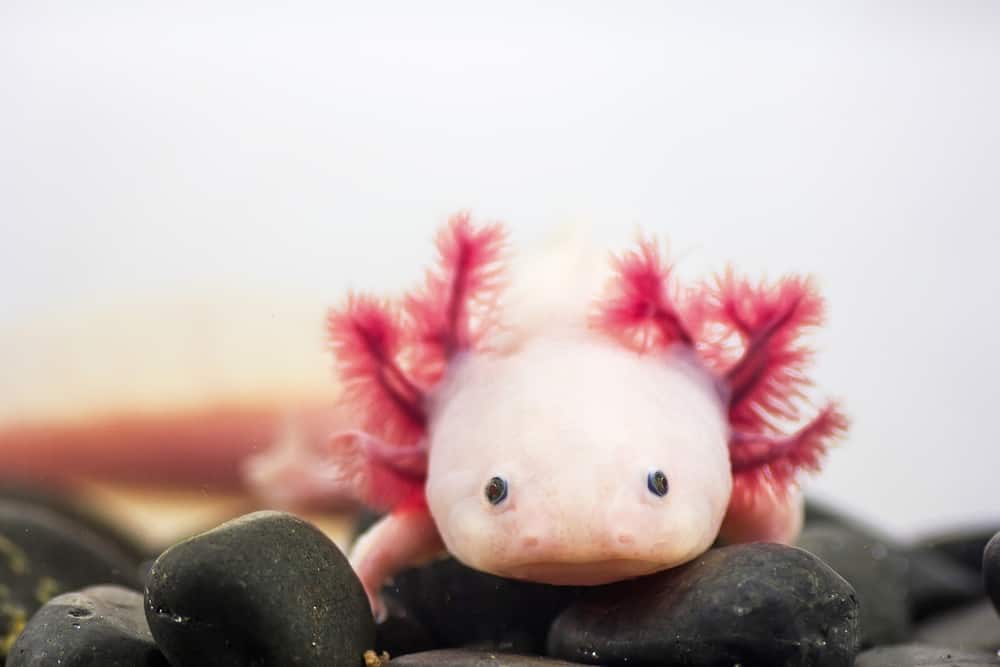
A bare-bottom tank is easier to clean but looks spartan, and many pet owners claim that it’s an unnatural setup.
On the other hand, axolotls tend to eat their substrate and may get impacted.
If you want to use a substrate for your axolotl, there are a safe few options that you can use. These include:
- Fine Aquarium Sand – This substrate consists of such tiny particles that, even if the axolotl swallows it, it’s unlikely to cause an impaction.
This is one of the best substrates for axolotls.
- Large River Rocks – Using large river rocks as a substrate gives the axolotl something to grip, without risk of impaction. They’re simply too large for the axolotl to swallow.
- Untreated Ceramic Tiles – You can line the bottom of the aquarium with untreated ceramic tiles. They’ll give the axolotl grip but are too large to swallow. Ensure that there aren’t any sharp edges or splinters on them.
- Slate – Slate makes a good substrate as you can buy it in large pieces and cover most of the tank’s floor. It offers grip but no impaction risk.
Sand is the best substrate, as it’s the most natural option and easy to clean and replace.
Diet
Axolotls eat a diet of live food. They were the top predators in their wild habitats before the introduction of exotic fish species.
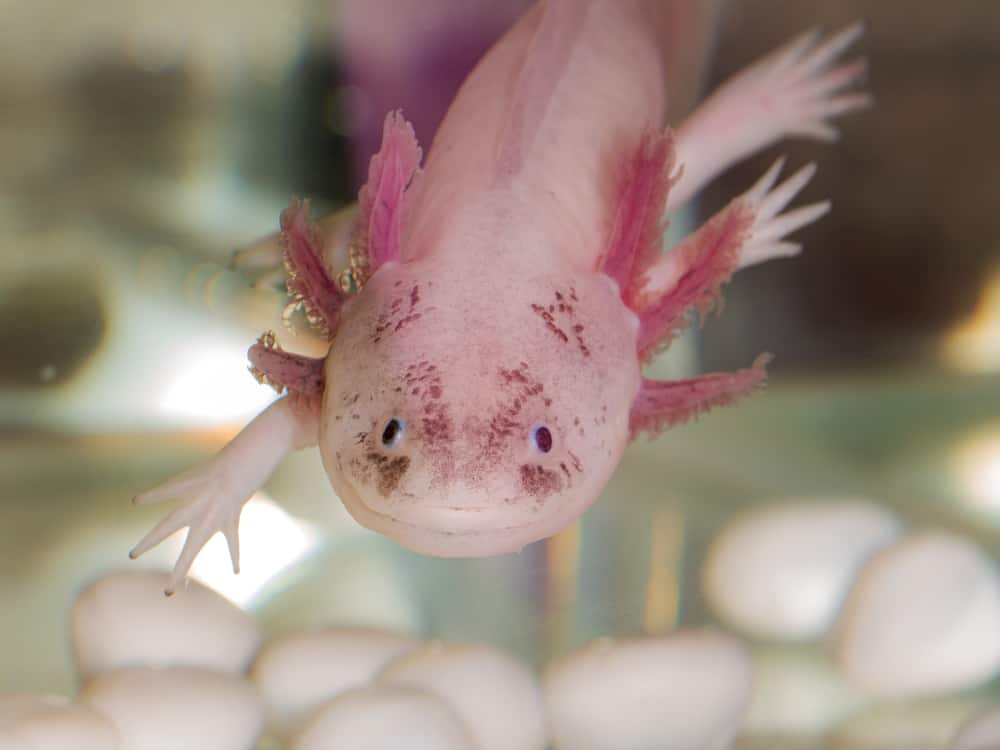
In captivity, these animals accept a wide range of live food. Some options include:
- Daphnia
- Bloodworms
- Brine shrimp
- Tubifex worms
- Mosquito larvae
If you’ve owned an aquarium, you’ll know where to find most of these.
Pet axolotls can also eat a wide range of prepared foods, including salmon pellets and prepared axolotl food.
We’ve also created a separate axolotl diet guide you can check out!
Temperature
Lake Xochimilco, where wild axolotls live, is a mountain lake and has cool temperatures.
Unless you live in a home that doesn’t have heating, and the temperature drops to freezing, your albino axolotl won’t need heating.
The albino axolotl, Ambystoma mexicanum, prefers a water temperature range of between 60 °F and 64 °F.
If you struggle to maintain even this low range, consider using a small aquarium heater.
Monitor the temperature at all times with an aquarium thermometer.
Ensure that the temperature doesn’t go over around 75 °F, aiming for 70 °F or less.
If you can offer the preferred range of 60-64°F, that’s the optimal solution.
Lighting
The albino axolotl is a bottom-dwelling salamander that tries to avoid bright lighting.
You can keep your axolotl healthy with nothing more than general room lighting or by placing them in a room that gets some indirect light.
NEVER place your axolotl’s enclosure in direct sunlight. It would be too bright and raise the temperature.
Since these animals don’t spend time on land like tiger salamanders and most other salamanders, they don’t need a basking light.
If you want to add lighting to the enclosure, ensure that it’s dim lighting.
Consider adding floating plants like duckweed or butterfly fern to help keep the lighting subdued. They’ll help to manage the nitrogen levels in the water.
LED bulbs are the best lighting option for your albino axolotl tank. They last longer, consume less energy, and don’t produce as much heat.
Pro Tip: Including plenty of hides, choosing low-light plants, and using a low-lumen LED bulb will help keep the tank dim for your axolotl.
Axolotl Enclosure Setup
Setting up an enclosure for axolotls is simple.
Here’s a step-by-step setup guide:
- Wash the tank and any hides or decorations with warm, soapy water.
- Rinse everything to remove any soap residue.
- Dry the tank, and position it in its permanent location. The enclosure will be heavy once filled, and you’ll go through a lot of effort to move it.
- If you’re going to use an under-gravel (UG) filter, place it in the enclosure. Connect all the tubes for it before adding the substrate.
- If you’re using sand as a substrate, place a layer of a fine mesh (like uncolored, untreated curtain mesh) over the UG f over the under-gravel filter.
- Position the hides and decoration where you plan on keeping them, anchoring them in the substrate.
- Place a saucer on the substrate, away from your decor, but in a place where you can pour into it. The saucer will help prevent the water from moving the substrate when you’re adding water.
- If you’re using reverse osmosis water, you can add it now. If you’re using tap water, now is the time to add the water conditioner. Condition the water, stir it, and then leave it for a few moments to take effect.
- Pour the water into the saucer, allowing it to drift over the side and into the enclosure. Once the water reaches the level of the saucer’s lip, you can pour faster and allow it to drift into the surrounding areas.
- If you’re planting live plants in the substrate, stop adding water when the tank is about halfway full.
- Position your plants where you want them, then continue adding water.
- Fill the tank till there are around two inches of space between the water and the tank’s top. With aquatic species that jump, like Ambystoma mexicanum, it’s always a good idea to leave two inches of headspace.
- Remove the saucer, and add any extra filtration that you’ll be using.
- If you have a friend with a healthy axolotl, you can ask them for a piece of their filter material to add to your filters. Doing so will help kick-start the filter bacteria and the nitrogen cycle.
- Give the aquarium two to three weeks to cycle before adding the axolotl, if you can. If you have that time to spend, it will help establish water health before you add your new pet.
- If you have healthy fish or know someone who does, consider adding a fish like a guppy or a molly. Having a fish in the aquarium while it cycles helps to activate the bacterial cultures.
- If you don’t have time to cycle the tank, consider buying a bacterial booster liquid. It’s a starter colony that comes in a dropper bottle, and you can add a few drops.
- Watch the water conditions (temperature, pH, etc.) and add your axolotl once they’ve settled.
- If you didn’t have time to cycle the tank, do 25% water changes daily for the first two weeks. This will prevent an ammonia or nitrate spike from killing your axolotl.
- After that, you can do a 50% change weekly.
Check out our in-depth guide on axolotl tank setup if you want to create the best condition to keep your pet happy!
Albino Axolotl Temperament
Whether you have a dark gray axolotl, a GFP (green fluorescent protein), or an albino, they’re a calm species.
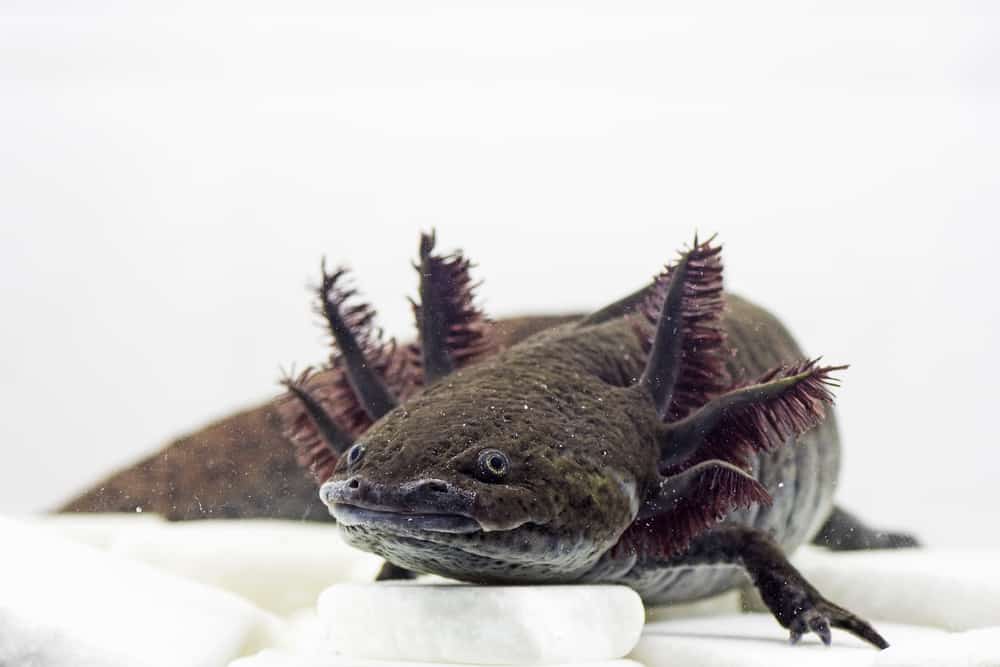
The axolotl is a display animal and not a pet as such. You shouldn’t try to handle your axolotl, as it stresses the animal.
These animals aren’t aggressive. However, axolotls will eat small fish, amphibians, and anything that fits in their mouths.
They’ll eat other axolotls if the other animal is small enough. It’s best to keep these animals on their own unless you plan on breeding them.
Albino Axolotl Lifespan
The albino axolotl has a lifespan of up to 15 years, with eight to 12 years being average.
We have no reliable record of the lifespan of an axolotl in the wild due to its rarity.
Albino Axolotl Price
Axolotls are easy to care for and breed well, which makes them affordable.
The albino axolotl, despite being the result of a recessive gene, has become common. You can expect to pay around $50 for one.
Even morphs like the GFP, produced through genetic modification to glow green, only cost around $75.
Albino Axolotls vs. Leucistic Axolotls
People often confuse albino axolotls and leucistic axolotls, but they’re quite distinct.
Leucistic axolotls are almost see-through, have dark eyes, and have red or pink gills. These axolotls have white skin with shiny golden flecks.
Leucistic animals have less pigment than normal animals, while albinos produce no pigment.
Albino axolotls come in a range of colors that include gold, white, and peach. They have reflective spots and pink gill stalks that may have a yellow tint.
Golden Albino Axolotl
Golden albino axolotls are albinos in every respect but retain a form of coloration.
Their eyes have no pigment, which makes them appear pink and reveals them as albinos.
The skin of these axolotls may be golden, yellow, peach, or cream.
White Albino Axolotl
White albino axolotls are the morph that most resemble the albinos we’re familiar with.
They’re white, with reflective speckles, red eyes, and pink gills.
Both white and golden albino axolotls share the same care needs as normal axolotls.
Are Wild Axolotls a Threatened Species?
Wild axolotls aren’t threatened; they’re, they’re critically endangered.
Axolotls have a small range, including one lake and a series of canals.
The drying up of water bodies (like Lake Chalco) for development purposes has reduced their old range.
Axolotls are a popular Mexican food, which places further pressure on wild populations. Invasive predators like tilapia are taking a toll.
Current population estimates range as low as 700 animals left in the wild.
Are Albino Axolotls Blind?
Albino axolotls aren’t blind, though all axolotls have poor eyesight.
These animals have lidless eyes, which suffer when lighting is bright.
The only difference between the eyes of different axolotls is that most morphs have black eyes and albino axolotls have red or pink eyes.
Are Axolotls Dangerous to Humans?
Axolotls aren’t dangerous to humans.
These are small animals that lack venom and only wish to escape you. You have nothing to fear from them.
Can Albino Axolotls Die?
Any living creature, including albino axolotls, can die.
Their lack of death is a myth that comes from the animal’s Mexican homelands.
The Aztecs named the axolotl after the god Xolotl, and rumors of its inability to die have followed it ever since.
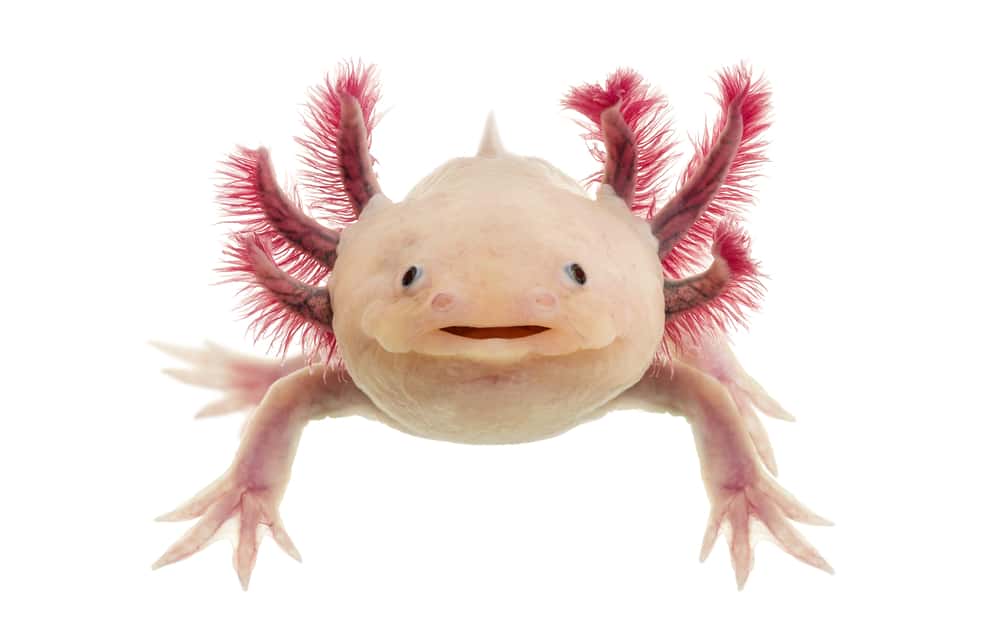
We hope you’ve enjoyed this article about the albino axolotl.
You can dive further into axolotl pet care in general or check out some of our other content for more informative articles.
Our reptile vs. amphibian comparison will teach you the difference between the two groups.
We also have articles about the world’s deadliest snakes and the largest pet lizards. If amphibians are your weakness, check out our frog tank article.
Or, if you’ve always wondered what the difference is, have a look at our frog vs. toad comparison.
Do you have a pet axolotl? If so, is it an albino? Let us know in the comments.
